Post-Transcriptional Induction of the Antiviral Host Factor GILT/IFI30 by Interferon Gamma
Abstract
:1. Introduction
2. Results
2.1. Post-Transcriptional Elevation of GILT Protein by IFN-γ in HeLa Cells
2.2. Post-Transcriptional Elevation of GILT Protein by IFN-γ in Other Cell Types
2.3. Absence of Activation of GILT Transcription by IFN-γ
2.4. GILT Protein Stability and Its Relationship with IFN-γ
2.5. Impact of Rapamycin on GILT Protein Induction by IFN-γ
2.6. Untranslated Region of GILT mRNA Inhibits Its Translation in the Absence of IFN-γ
2.7. STAT1 Phosphorylation Is Necessary for IFN-γ-Mediated GILT Protein Induction
3. Discussion
4. Materials and Methods
4.1. Plasmids
4.2. Cells
4.3. Peripheral Blood Mononuclear Cells
4.4. Amphotropic Murine Leukemia Virus Vector
4.5. Western Blotting
4.6. Luciferase Activity
4.7. Protein Stability
4.8. Droplet Digital PCR
5. Conclusions
Author Contributions
Funding
Institutional Review Board Statement
Informed Consent Statement
Data Availability Statement
Acknowledgments
Conflicts of Interest
References
- Maric, M.; Arunachalam, B.; Phan, U.T.; Dong, C.; Garrett, W.S.; Cannon, K.S.; Alfonso, C.; Karlsson, L.; Flavell, R.A.; Cresswell, P. Defective antigen processing in GILT-free mice. Science 2002, 294, 1361–1365. [Google Scholar] [CrossRef]
- Singh, R.; Cresswell, P. Defective cross-presentation of viral antigens in GILT-free mice. Science 2010, 328, 1394–1398. [Google Scholar] [CrossRef] [PubMed]
- Ewanchuk, B.W.; Yates, R.M. The phagosome and redox control of antigen processing. Free. Radic. Biol. Med. 2018, 125, 53–61. [Google Scholar] [CrossRef] [PubMed]
- Rausch, M.P.; Hastings, K.T. Diverse cellular and organismal functions of the lysosomal thiol reductase. Mol. Immunol. 2015, 68, 124–128. [Google Scholar] [CrossRef] [PubMed]
- Izumida, M.; Hayashi, H.; Smith, C.; Ishibashi, F.; Suga, K.; Kubo, Y. Antivirus activity, but not thiolreductase activity, is conserved in interferon-gamma-inducible GILT protein in arthropod. Mol. Immunol. 2021, 140, 240–249. [Google Scholar] [CrossRef]
- Kubo, Y.; Izumida, M.; Yashima, Y.; Yoshii-Kamiyama, H.; Tanaka, Y.; Yasui, K.; Hayashi, H.; Mastuyama, T. Gamma-interferon-inducible, lysosome/endosome-localized thiolreductase, GILT, has anti-retroviral activity and its expression is counteracted by HIV-1. Oncotarget 2016, 7, 71255–71273. [Google Scholar] [CrossRef]
- Schleicher, T.R.; Yang, J.; Freudzon, M.; Rembisz, A.; Craft, S.; Hamilton, M.; Graham, M.; Mlambo, G.; Tripathi, A.K.; Li, Y.; et al. A mosquito salivary gland protein partially inhibits Plasmodium sporozoite traversal and transmission. Nature Commum. 2018, 9, 2908. [Google Scholar] [CrossRef]
- Kongton, K.; McCall, K.; Phongdara, A. Identification of gamma-interferon-inducible lysosomal thiol reductase (GILT) homoloques in the fruit fly Drosophila melanogaster. Dev. Comp. Immunol. 2014, 44, 389–396. [Google Scholar] [CrossRef]
- Thipwong, J.; Saelim, H.; Panrat, T.; Phongdara, A. Penaeus monodon GILT enzyme restyricts WSSV infectivity by reducing disulfide bonds in WSSV proteins. Dis. Aquat. Organ. 2019, 135, 59–70. [Google Scholar] [CrossRef]
- Chen, D.; Hou, Z.; Jiang, D.; Zheng, M.; Li, G.; Zhang, Y.; Li, R.; Lin, H.; Chang, J.; Zeng, H.; et al. GILT restricts the cellular entry mediated by the envelope glycoproteins of SARS-CoV, Ebola virus, and Lassa fever virus. Emerg. Microbes Infect. 2019, 8, 1511–1523. [Google Scholar] [CrossRef]
- Darnell, J.E., Jr.; Kerr, I.M.; Stark, G.R. Jak-STAT pathways and transcriptional activation in response to IFNs and other extracellular signaling proteins. Science 1994, 264, 1415. [Google Scholar] [CrossRef]
- Kubo, Y.; Yasui, K.; Izumida, M.; Hayashi, H.; Matsuyama, T. IDO1, FAT10, IFI6, and GILT are involved in the antiretroviral activity of γ-interferon and IDO1 restricts retrovirus infection by autophagy enhancement. Cells 2022, 11, 2240. [Google Scholar] [CrossRef] [PubMed]
- Inouye, S.; Watanabe, K.; Nakamura, H.; Shimomura, O. Secretional luciferase of the luminous shrimp Oplophorus gracilirostris: cDNA cloning of a novel imidazopyrazinone luciferase. FEBS Lett. 2000, 481, 19–25. [Google Scholar] [CrossRef]
- Chatterjee-Kishore, M.; Wright, K.L.; Ting, J.P.; Stark, G.R. How Stat1 mediates constitutive gene expression: A complex of unphosphorylated Stat1 and IRF1 supports transcription of the LMP2 gene. EMBO J. 2000, 19, 4111–4122. [Google Scholar] [CrossRef]
- Shi, G.; Ozog, S.; Torbett, B.E.; Compton, A.A. mTOR inhibitors lower an intrinsic barrier to virus infection mediated by IFITM3. Proc. Natl. Acad. Sci. USA 2018, 115, E10069–E10078. [Google Scholar] [CrossRef]
- Frank, D.A.; Mahajan, S.; Ritz, J. Fludarabine-induced immunosuppression is associated with inhibition of STAT1 signaling. Nature Med. 1999, 5, 444–447. [Google Scholar] [CrossRef] [PubMed]
- Buetow, K.H.; Meador, L.R.; Menon, H.; Lu, Y.K.; Brill, J.; Cui, H.; Roe, D.J.; DiCaudo, D.J.; Hastings, K.T. High GILT expression and an active and intact MHC class II antigen presentation pathway are associated with improved survival in melanoma. J. Immunol. 2019, 203, 2577–2587. [Google Scholar] [CrossRef] [PubMed]
- Nguyen, J.; Bernert, R.; In, K.; Kang, P.; Sebastiao, N.; Hu, C.; Hastings, K.T. Gamma-interferon-inducible lysosomal thiol reductase is upregulated in human melanoma. Melanoma Res. 2016, 26, 125–137. [Google Scholar] [CrossRef]
- Phipps-Yonas, H.; Cui, H.; Sebastiao, N.; Brunhoeber, P.S.; Haddock, E.; Deymier, M.J.; Klapper, W.; Lybarger, L.; Roe, D.J.; Hastings, K.T. Low GILT expression is associated with poor patient survival in diffuse large B-cell lymphoma. Front. Immunol. 2013, 4, 425. [Google Scholar] [CrossRef]
- Jiang, W.; Zheng, F.; Yao, T.; Gong, F.; Zheng, W.; Yao, N. IFI30 as a prognostic biomarker and correlation with immune infiltrates in glioma. Ann. Transl. Med. 2021, 9, 1686. [Google Scholar] [CrossRef]
- Liu, X.; Song, C.; Yang, S.; Ji, Q.; Chen, F.; Li, W. IFI30 expression is an independent unfavourable prognostic factor in glioma. J. Cell. Mol. Med. 2020, 24, 12433–12443. [Google Scholar] [CrossRef] [PubMed]
- Zhu, C.; Chen, X.; Guan, G.; Zou, C.; Guo, Q.; Cheng, P.; Cheng, W.; Wu, A. IFI30 is a novel immune-related target with predicting value of prognosis and treatment response in glioblastoma. Onco. Targets Ther. 2020, 13, 1129–1143. [Google Scholar] [CrossRef] [PubMed]
- Ye, C.; Zhou, W.; Wang, F.; Yin, G.; Zhang, X.; Kong, L.; Gao, Z.; Feng, M.; Zhou, C.; Sun, D.; et al. Profnostic value of gamma-interferon-inducible lysosomal thiol reductase expression in female patients diagnosed with breast cancer. Int. J. Cancer 2020, 150, 705–717. [Google Scholar] [CrossRef] [PubMed]
- Fan, Y.; Wang, X.; Li, Y. IFI30 expression predicts patient prognosis in breast cancer and dictates breast cancer cells proliferation via regulating autophagy. Int. J. Med. Sci. 2021, 18, 3342–3352. [Google Scholar] [CrossRef] [PubMed]
- Stefanovic, M.; Zivotic, I.; Stojkovic, L.; Dincic, E.; Stankovic, A.; Zivkovic, M. The association of genetic variants IL2RA rs2104286, IFI30 rs11554159, and IKZF3 rs12946510 with multiple sclerosis onset and severity in patients from Serbia. J. Neuroimmunol. 2020, 347, 577346. [Google Scholar] [CrossRef]
- Rausch, M.P.; Irvine, K.R.; Antony, P.A.; Restifo, N.P.; Cresswell, P.; Hastings, K.T. GILT accelerates autoimmunity to the melanoma antigen tyrosinase-related protein 1. J. Immunol. 2010, 185, 2828–2835. [Google Scholar] [CrossRef]
- Maric, M.; Barjaktarevic, I.; Bogunovic, B.; Stojakovic, M.; Maric, C.; Vukmanovic, S. Developmental up-regulation of IFN-gamma-inducible lysosomal thiol reductase expression leads to reduced T cell sensitivity and cell severe autoimmunity. J. Immunol. 2009, 182, 746–750. [Google Scholar] [CrossRef]
- O’Donnell, P.W.; Haque, A.; Klemsz, M.J.; Kaplan, M.H.; Blum, J.S. Induction of the antigen-processing enzyme IFN-γ-inducible lysosomal thiol reductase in melanoma cells is STAT1-dependent but CIITA-independent. J. Immunol. 2004, 173, 731–735. [Google Scholar] [CrossRef]
- Srinivasan, P.; Maric, M. Signal transducer and activator of transcription 1 negatively regulates constitutive gamma interferon-inducible lysosomal thiol reductase expression. Immunology 2010, 132, 209–216. [Google Scholar] [CrossRef]
- Burrows, G.G.; Meza-Romero, R.; Huan, J.; Sinha, S.; Mooney, J.L.; Vandenbark, A.A.; Offner, H. GILT required for RTL550-CYS-MOG to treat experimental sutoimmune encephalomyelitis. Metab. Brain Dis. 2012, 27, 143–149. [Google Scholar] [CrossRef]
- Maenaka, A.; Iwasaki, K.; Ota, A.; Miwa, Y.; Ohashi, W.; Horimi, K.; Matsuoka, Y.; Ohnishi, M.; Uchida, K.; Kobayashi, T. Interferon-γ-induced HLA class II expression on endothelial cells is decreased by inhibition of mTOR and HMG-CoA reductase. FEBS Open Bio. 2020, 10, 927–936. [Google Scholar] [CrossRef]
- Kroczynska, B.; Mehrotra, S.; Arslan, A.D.; Kaur, S.; Platanias, L.C. Regulation of interferon-dependent mRNA translation of target genes. J. Interferon Cytokine Res. 2014, 34, 289–296. [Google Scholar] [CrossRef]
- Kaur, S.; Lal, L.; Sassano, A.; Majchrzak-Kita, B.; Srikanth, M.; Baker, D.P.; Petroulakis, E.; Hay, N.; Sonenberg, N.; Fish, E.N.; et al. Regulatory effects of mammalian target of rapamycin-activated pathways in thpe I and II interferon signaling. J. Biol. Chem. 2007, 282, 1757–1768. [Google Scholar] [CrossRef]
- Kaur, S.; Sassano, A.; Dolniak, B.; Joshi, S.; Majchrzak-Kita, B.; Baker, D.P.; Hay, N.; Fish, E.N.; Platanias, L.C. Role of the Akt pathway in mRNA translation of interferon-stimulated genes. Proc. Natl. Acad. Sci. USA 2008, 105, 4808–4813. [Google Scholar] [CrossRef] [PubMed]
- Naldini, L.; Blomer, U.; Gallay, P.; Ory, D.; Mulligan, R.; Gage, F.H.; Verma, I.M.; Trono, D. In vivo gene delivery and stable transduction of nondividing cells by a lentiviral vector. Science 1996, 272, 263–267. [Google Scholar] [CrossRef] [PubMed]
- Kubo, Y.; Tominaga, C.; Yoshii, H.; Kamiyama, H.; Mitani, C.; Amanuma, H.; Yamamoto, N. Characterization of R peptide of murine leukemia virus envelope glycoproteins in syncytium formation and entry. Arch. Virol. 2007, 152, 2169–2182. [Google Scholar] [CrossRef] [PubMed]
- Chang, L.J.; Urlacher, V.; Iwakuma, T.; Cui, Y.; Zucali, J. Efficacy and safety analysis of a recombinant human immunodeficiency virus type 1 derived vector system. Gene Ther. 1999, 6, 715–728. [Google Scholar] [CrossRef]
- Meregildo-Rodriguez, E.D.; Asmat-Rubio, M.G.; Vasquez-Tirado, G.A. Droplet digital PCR vs. quantitative real time-PCR for diagnosis of pulmonary and extrapulmonary tuberculosis: Systematic review and meta-analysis. Front. Med. 2023, 10, 1248842. [Google Scholar] [CrossRef]



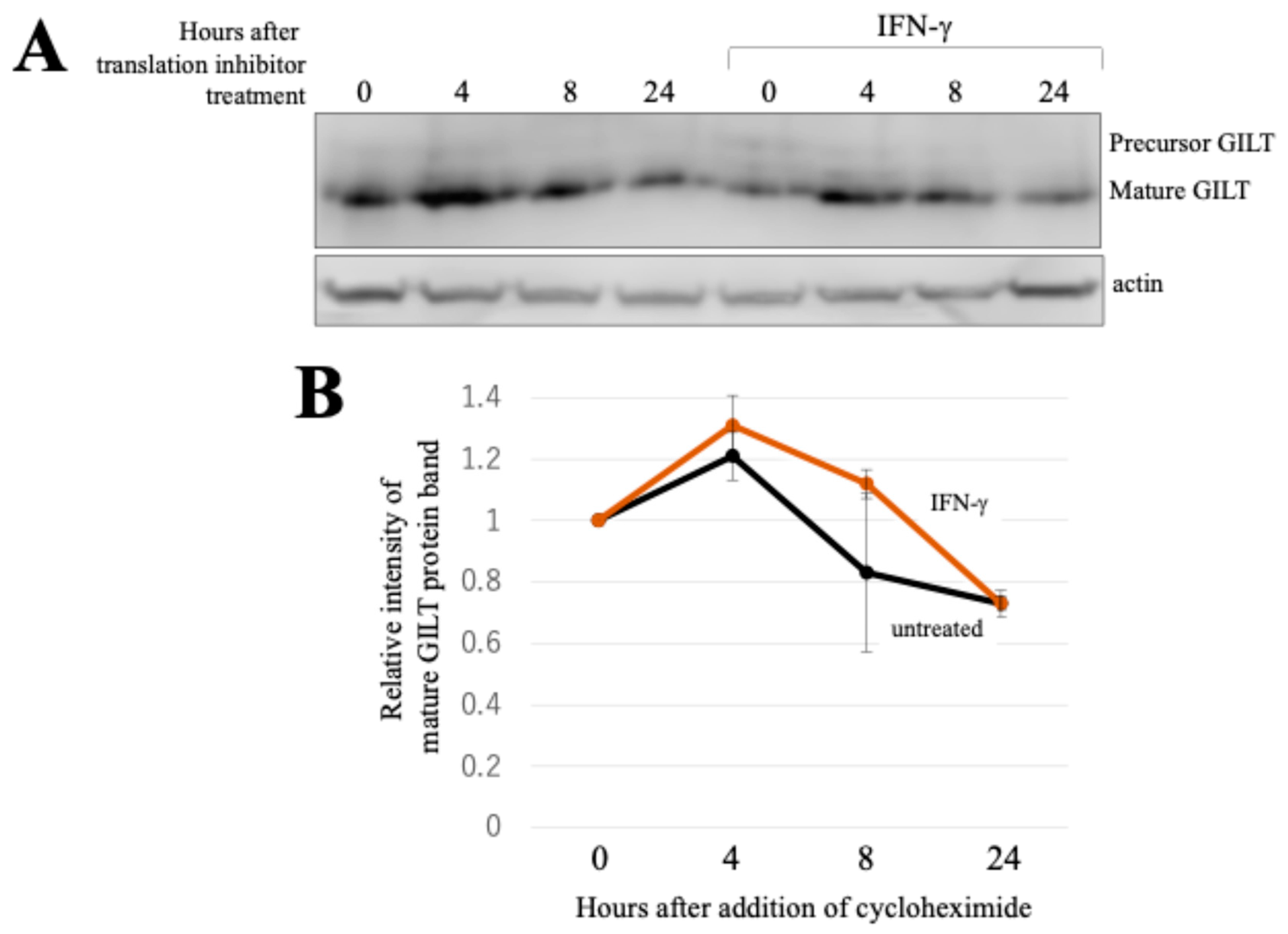

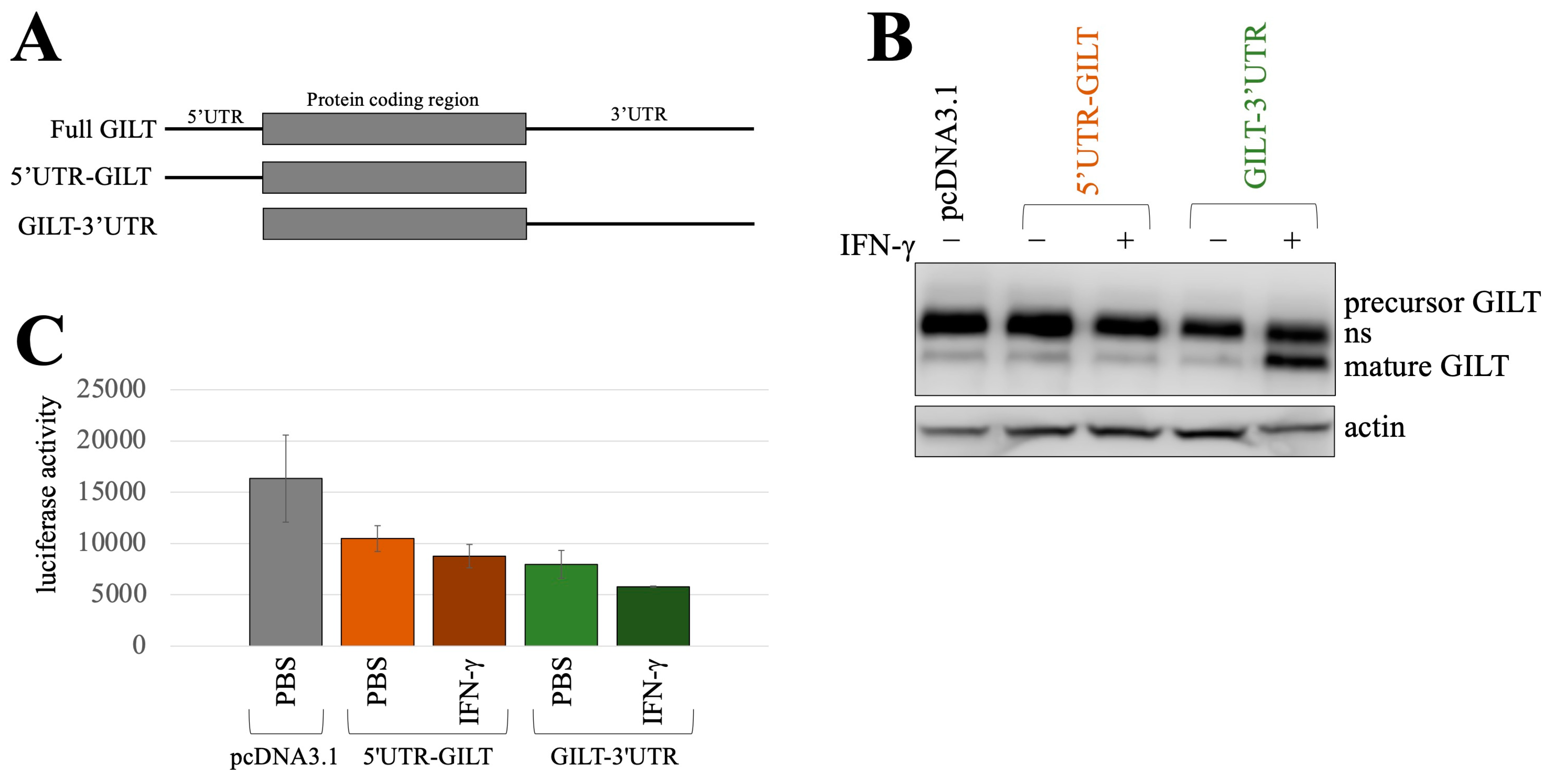
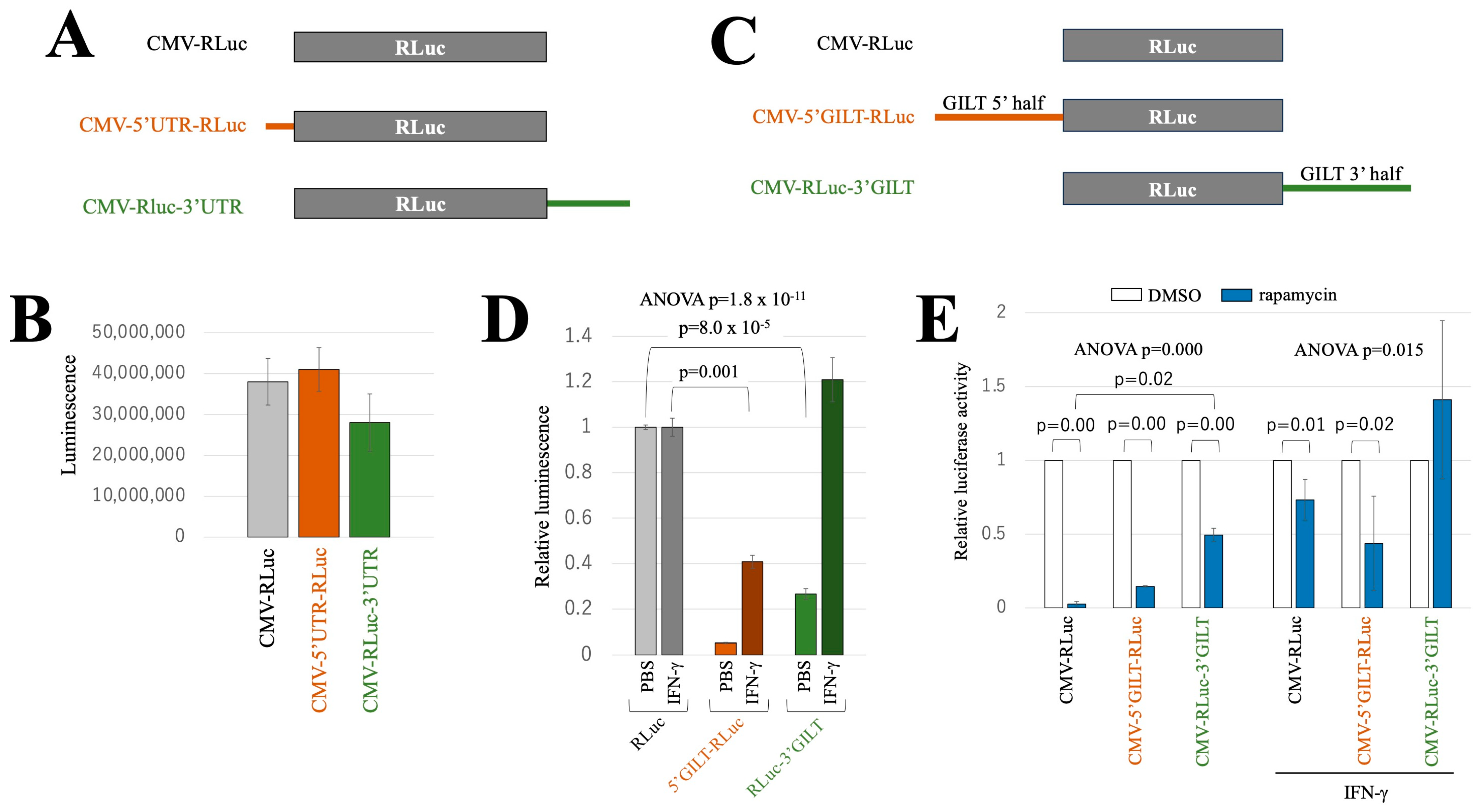
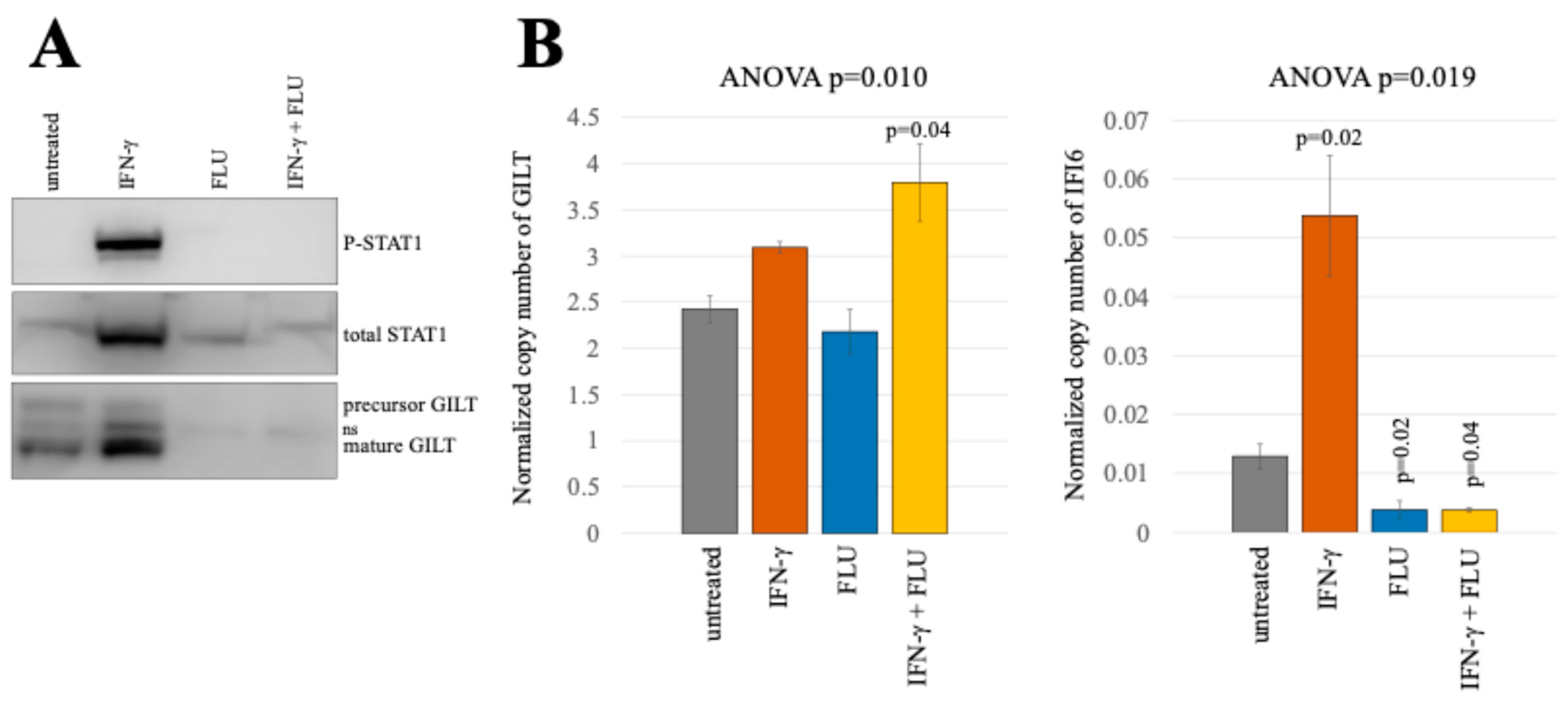
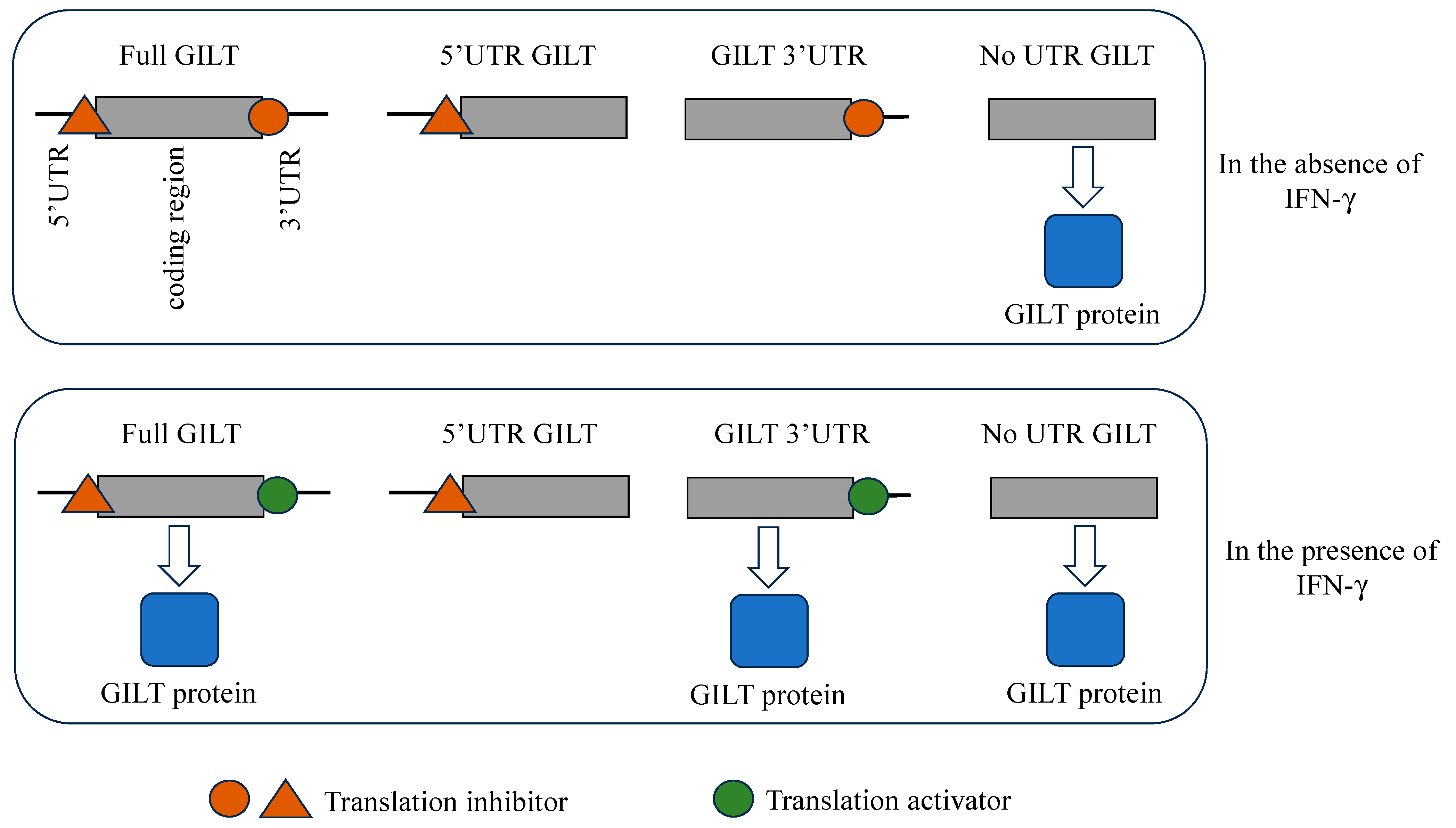
| Primers | Nucleotide Sequences |
|---|---|
| 5′ UTR sense | CTGCAGTCGCCACACCTTGC |
| GILT sense | ATGACTTCGAAAGTTTATGAT |
| GILT antisense | CACTTGAAGCAAACACTCCTG |
| 5′ UTR-RLuc sense | CTGCAGTCGCCACACCTTTGCCCCTGCTG (5′ UTR of GILT) CG ATGACTTCGAAAGTTTATGAT (RLuc) |
| RLuc antisense | TTATTGTTCATTTTTGAGAACTCGC |
| 3′ UTR sense | TGGCCGGTGAGCTGCGGAGAG |
| 3′ UTR antisense | GCTTATTAAACTAGTTTTACTTTAGC |
| GAPDH sense | CCATGCCATCACTGCCACCC |
| GAPDH antisense | GCCAGTGAGCTTCCCGTTCAG |
| GILT 532 antisense | CTACAGGCATAGTGGCAGACT |
| IFI6 sense | GCGCGCGGCGCCACCATGCGG |
| IFI6 antisense | TGGCTACTCCTCATCCTCCTC |
Disclaimer/Publisher’s Note: The statements, opinions and data contained in all publications are solely those of the individual author(s) and contributor(s) and not of MDPI and/or the editor(s). MDPI and/or the editor(s) disclaim responsibility for any injury to people or property resulting from any ideas, methods, instructions or products referred to in the content. |
© 2024 by the authors. Licensee MDPI, Basel, Switzerland. This article is an open access article distributed under the terms and conditions of the Creative Commons Attribution (CC BY) license (https://creativecommons.org/licenses/by/4.0/).
Share and Cite
Nakamura, T.; Izumida, M.; Hans, M.B.; Suzuki, S.; Takahashi, K.; Hayashi, H.; Ariyoshi, K.; Kubo, Y. Post-Transcriptional Induction of the Antiviral Host Factor GILT/IFI30 by Interferon Gamma. Int. J. Mol. Sci. 2024, 25, 9663. https://doi.org/10.3390/ijms25179663
Nakamura T, Izumida M, Hans MB, Suzuki S, Takahashi K, Hayashi H, Ariyoshi K, Kubo Y. Post-Transcriptional Induction of the Antiviral Host Factor GILT/IFI30 by Interferon Gamma. International Journal of Molecular Sciences. 2024; 25(17):9663. https://doi.org/10.3390/ijms25179663
Chicago/Turabian StyleNakamura, Taisuke, Mai Izumida, Manya Bakatumana Hans, Shuichi Suzuki, Kensuke Takahashi, Hideki Hayashi, Koya Ariyoshi, and Yoshinao Kubo. 2024. "Post-Transcriptional Induction of the Antiviral Host Factor GILT/IFI30 by Interferon Gamma" International Journal of Molecular Sciences 25, no. 17: 9663. https://doi.org/10.3390/ijms25179663






